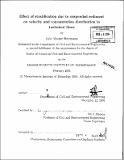Effect of stratification due to suspended sediment on velocity and concentration distribution in turbulent flows
Author(s)
Herrmann, Julie Marine, 1977-
DownloadFull printable version (5.771Mb)
Other Contributors
Massachusetts Institute of Technology. Dept. of Civil and Environmental Engineering.
Advisor
Ole S. Madsen.
Terms of use
Metadata
Show full item recordAbstract
(cont.) An examination of the effects of uncertainty in the predictive capability of our model reveals that this overshadows the slight improvement resulting from accounting for stratification. Finally, our stratification model appears to be nearly equivalent to making von Karman's constant a variable as done in the earliest attempts to account for stratification in sediment-laden flows. Sediment-induced stratification effects on velocity profiles and sediment concentration distribution in a steady, uniform turbulent flow are examined in this thesis. The early work concerning sediment stratification relates this to von Karman's constant's variability. Subsequent attempts to account for stratification were based on the stratified flow analogy, introducing the parameters α and β, whose values were assumed to be those obtained for thermally stratified flows. Following these investigators, we assume stratification effects to be expressed through these parameters. We solve the governing equations for velocity and sediment concentration for a parabolic, a simplified linear-constant and an extremely simplified linear neutral eddy viscosity model. Analytically closed form solutions are obtained. The parabolic and linear-constant models' formulae require numerical evaluation of integrals. The linear model provides excellent estimates of velocity and concentration and does not require numerical computation. We run our model against experimental data to obtain the optimal set [α, β]. For neutral conditions, β = 0 by definition, and we obtain α = 1. For stratified conditions the optimal values are α = 0.8 and β = 4.0. Accounting for stratification slightly improves the prediction of velocity and concentration in comparison with the case where we do not account for it. For predictive purposes, we need to know the movable bed roughness and the reference concentration. Analyses of experimental data sets provide predictive relationships for reference concentration and movable bed roughness in terms of sediment and flow parameters.
Description
Thesis (S.M.)--Massachusetts Institute of Technology, Dept. of Civil and Environmental Engineering, 2004. Includes bibliographical references (p. 149-152).
Date issued
2004Department
Massachusetts Institute of Technology. Department of Civil and Environmental EngineeringPublisher
Massachusetts Institute of Technology
Keywords
Civil and Environmental Engineering.